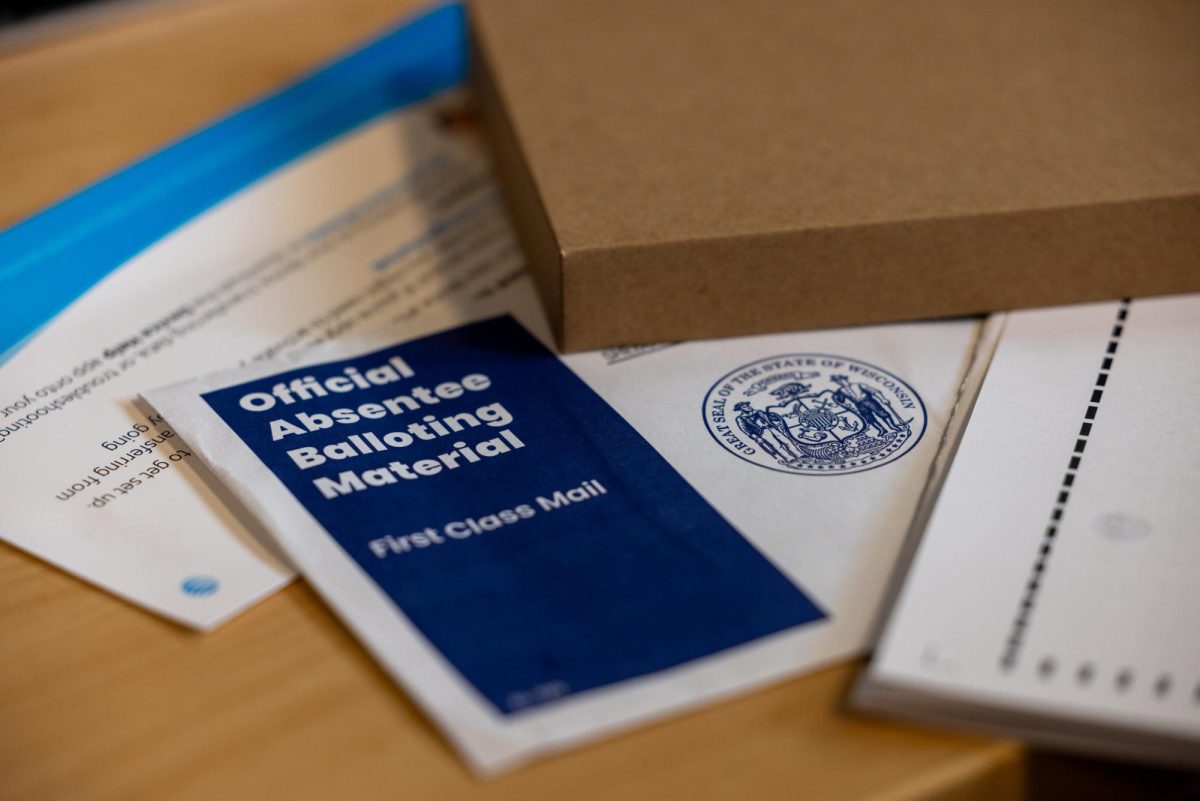From the maíz fields of Mexico to his own Sauk County dairy farm, fourth-generation farmer John Kinsman says he has seen the downside of the recent rise in U.S. ethanol production.
As president of the Wisconsin non-profit Family Farm Defenders, Kinsman traveled to Mexico last month to discuss the effects of ethanol with local farmers. For the past four years, the group has monitored the expansion of the use of ethanol, or grain alcohol, as an alternative energy source in both Wisconsin and around the world.
According to the Wisconsin Bio Industry Alliance, the majority of gasoline sold in Wisconsin now contains some blend of ethanol.
Although he initially hoped biofuels like ethanol would help drivers and farmers alike, Kinsman has since grown leery of the energy source, especially the corn-based ethanol comprising most of the current U.S. supply.
“There’s unanimous support for a different way of producing substitute energy,” Kinsman said. “We need to use a variety of means, maybe some ethanol and biodiesel, but not to the extent it’s going now.”
Even as federal legislation calls for more renewable fuels — a 2007 national energy standard set a goal of 36 billion gallons by 2022 — and Wisconsin considers a similar measure, a string of research findings have tempered enthusiasm for ethanol.
Most recently, a study co-authored by a University of Wisconsin professor predicted dire environmental consequences from fertilizer used to grow the additional corn needed to meet the growing ethanol demand. Two studies published in the journal Science earlier this year found production of almost all biofuels causes a net increase in greenhouse gas emissions.
In addition, Kinsman and others blamed corn-based ethanol for exacerbating farmers’ financial woes.
At the same time, proponents maintain heightened ethanol production will create jobs, reduce pollution, begin to wean the U.S. off foreign oil and pave the way for bigger and better forms of renewable energy. And the momentum of government regulations and funding is on their side.
As corn grows, fertilizer flows
In the brief but meteoric history of biofuel ethanol in the U.S., 2007 was yet another banner year, with nearly seven billion gallons of ethanol produced for fuel.
Wisconsin ethanol production also charged ahead, totaling approximately 300 million gallons, according to the USDA National Agricultural Statistics Service. If the past is any indication, more ethanol will require more land for corn: Between 2006 and 2007, corn cultivation in Wisconsin rose by 10 percent, according to the UW study authors.
For a diverse roster of pro-ethanol groups, the surge in production bodes well for the country’s environmental and economic future.
“Ethanol reduces dependency on foreign oil, reduces particulate and greenhouse gas emissions and … reduces the cost of gasoline,” said Josh Morby, Executive Director of the Wisconsin Bio Industry Alliance.
Increased ethanol use, however, has come with the scrutiny provided by a growing body of scientific research.
“It’s spreading like wildfire before anyone can do any thorough analysis of the trade-offs,” said Dr. Chris Kucharik of the UW-Madison Center for Sustainability and the Global Environment. Kucharik co-authored a recent study on the environmental effects of ethanol with Dr. Simon Donner, an assistant professor at the University of British Columbia who received his doctorate at UW-Madison.
The two scientists employed computer models to predict that reducing fertilizer pollution of the Mississippi River would be impossible with increased ethanol production. Given the USDA estimates of the greater amounts of land and fertilizer required to grow enough corn to meet the national renewable fuel goals, nitrogen pollution from fertilizer run-off will likely worsen the oxygen-depleted “dead zone” in the Gulf of Mexico, they wrote.
“Over the past couple of years, we’ve read things saying, ‘We think corn production is likely to expand the dead zone,’” Kucharik said. “We were in a perfect position to be able to support people and give an actual number to be used in policy making.”
Kucharik sees his research as part of a larger corpus that will gradually reveal the complicated implications of ethanol production, “bridging the gap between the sort of entities that don’t talk to each other even on this campus,” he said.
“These are the kind of studies that still need to be done, studies that integrate the natural science side of things with the social and economic sides,” he said.
Environmentally friendly ethanol a myth?
Donner and Kucharik’s findings join a host of other environmental concerns over ethanol production, which has traditionally been viewed as a green industry.
In two studies published by the journal Science in February, scientists from Princeton University and the Nature Conservancy found that biofuel production results in a worldwide gain in greenhouse gases, since the carbon dioxide released by clearing cropland outweighs that saved by biofuel use.
Transportation of corn to ethanol distilleries, the distillation process and the petroleum-based fertilizers used to grow corn require energy and contribute to emissions, Kinsman said.
“We’re finding the amount of fossil fuels being used to produce corn for ethanol [is] not cost-efficient,” Kinsman said.
“The only part of ethanol that we feel at this point is efficient is small farms or small ethanol plants that use a local product and that don’t harm food production,” he added.
The development of cropland for ethanol can also be harmful at the local level, said Eric Uram, the conservation chair for the John Muir Chapter of the Sierra Club.
“There’s increased competition for something that should be a food source but is more profitable as a fuel source,” Uram said.
As a result, more land will be taken out of government conservation programs that pay farmers to let acreage lie fallow, diminishing soil quality and displacing wildlife, he said.
Food versus fuel
Changes in land use can also provoke international repercussions, as the loss food-producing cropland in the U.S. forces other countries to pick up the slack, according to Kinsman and Uram.
U.S. ethanol use is wasteful in light of the current worldwide and U.S. food shortages, Kinsman said.
According to Morby, however, ethanol has little effect on human food supply, since ethanol is made from animal feed corn. And ethanol and feed corn are not mutually exclusive; the distiller’s grain left over from ethanol production in Wisconsin is usually fed to animals.
“It’s not an ‘either/or’, it’s an ‘and,’” Morby said.
But drying the “wet mass” of distiller’s grain to prolong its shelf life takes enormous amounts of energy, according to hay farmer Pete Hardin, who publishes the monthly dairy industry newspaper The Milkweed. In addition, the feed itself can pose health risks, Hardin said, pointing to a Kansas State University study that found a higher incidence of E. coli bacteria in cattle that are fed distiller’s grain.
Finally, Kinsman and Hardin said the heightened corn prices caused by demand for ethanol put the squeeze on many farmers financially. Especially hard hit are dairy farmers, who must now buy feed corn at higher prices, even as other costs are rising and the price they receive for milk is falling.
Wisconsin Farmers Union President Sue Beitlich, however, called the financial difficulties imputed to ethanol “growing pains” of transitioning to an ethanol-dominated marketplace.
“Nobody likes to see input costs rise, but we have to come up with something else to burn in our vehicles,” Beitlich said. “We have to be looking at alternative sources of energy, and corn happens to be the first one.”
A step in the right direction?
Regardless of its possible problems, many view corn ethanol as a necessary first step toward renewable fuel sources.
“This was the low-hanging fruit that was able to be plucked,” Kucharik said. “It has attracted a lot of attention to the idea of renewable energy and biofuels. … It’s something a lot of people in the Midwest can relate to. We’ve been making alcohol out of food crops for a long, long time.”
The Wisconsin Office of Energy Independence, which Gov. Jim Doyle created last April to promote renewable energy, supports corn-based ethanol as the best method of alternative fuel at present, according to biofuels sector specialist Maria Redmond.
“We want to look at other food stocks so we don’t have to plant more and more corn to meet ethanol production needs,” Redmond said, noting possibilities for conversion of forestry and other biomass products into biofuel.
Another oft-cited improvement is cellulosic ethanol production, a still-untested process that converts parts of the corn plant besides the ear into fuel. But even this may hold veiled difficulties, Uram said, since the stalk and other unused parts normally decompose to fertilize cropland. Kucharik noted this could cause increased soil erosion and run-off.
“There’s no way we can drill, split or harvest our way out of the current energy problem,” Uram said. “We all need to understand that conserving energy and making all our energy uses more efficient are the keys. Ethanol is, at best, only a temporary solution on the transportation side of things."
All sides agree, however, that for now, corn remains virtually the only source for ethanol production in Wisconsin. And ethanol capacity will only increase: Wisconsin is on pace to produce nearly 500 million gallons of ethanol in 2008, according to Morby.
“[Our research] wasn’t a hit piece on corn ethanol,” Kucharik said. “But we need to be careful with such monumental decisions to transform our energy sources.”













